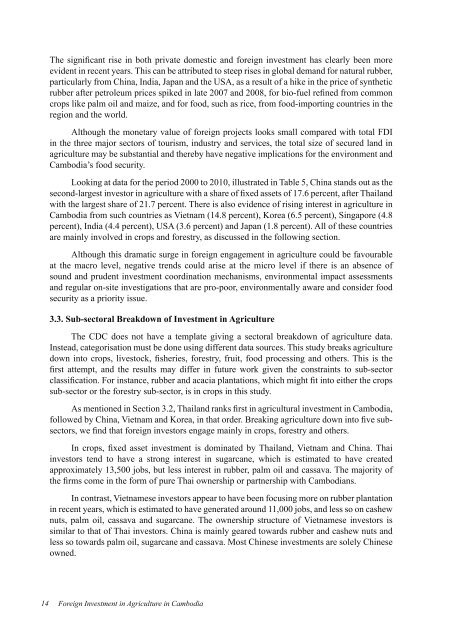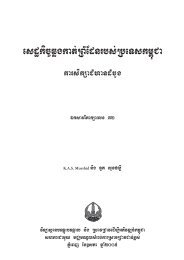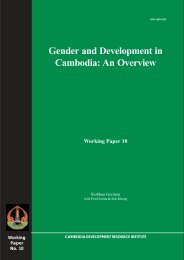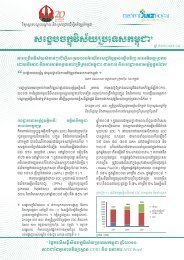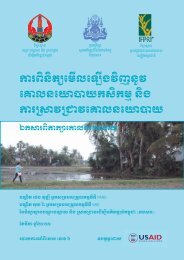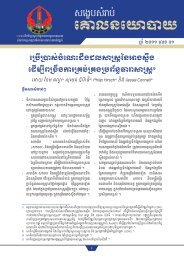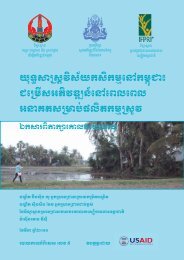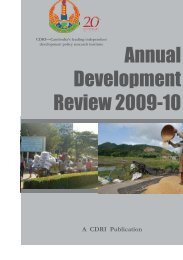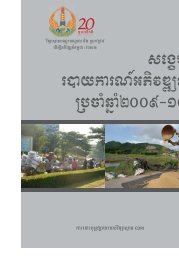Foreign Investment in Agriculture in Cambodia CDRI Working Paper ...
Foreign Investment in Agriculture in Cambodia CDRI Working Paper ...
Foreign Investment in Agriculture in Cambodia CDRI Working Paper ...
Create successful ePaper yourself
Turn your PDF publications into a flip-book with our unique Google optimized e-Paper software.
The significant rise <strong>in</strong> both private domestic and foreign <strong>in</strong>vestment has clearly been more<br />
evident <strong>in</strong> recent years. This can be attributed to steep rises <strong>in</strong> global demand for natural rubber,<br />
particularly from Ch<strong>in</strong>a, India, Japan and the USA, as a result of a hike <strong>in</strong> the price of synthetic<br />
rubber after petroleum prices spiked <strong>in</strong> late 2007 and 2008, for bio-fuel ref<strong>in</strong>ed from common<br />
crops like palm oil and maize, and for food, such as rice, from food-import<strong>in</strong>g countries <strong>in</strong> the<br />
region and the world.<br />
Although the monetary value of foreign projects looks small compared with total FDI<br />
<strong>in</strong> the three major sectors of tourism, <strong>in</strong>dustry and services, the total size of secured land <strong>in</strong><br />
agriculture may be substantial and thereby have negative implications for the environment and<br />
<strong>Cambodia</strong>’s food security.<br />
Look<strong>in</strong>g at data for the period 2000 to 2010, illustrated <strong>in</strong> Table 5, Ch<strong>in</strong>a stands out as the<br />
second-largest <strong>in</strong>vestor <strong>in</strong> agriculture with a share of fixed assets of 17.6 percent, after Thailand<br />
with the largest share of 21.7 percent. There is also evidence of ris<strong>in</strong>g <strong>in</strong>terest <strong>in</strong> agriculture <strong>in</strong><br />
<strong>Cambodia</strong> from such countries as Vietnam (14.8 percent), Korea (6.5 percent), S<strong>in</strong>gapore (4.8<br />
percent), India (4.4 percent), USA (3.6 percent) and Japan (1.8 percent). All of these countries<br />
are ma<strong>in</strong>ly <strong>in</strong>volved <strong>in</strong> crops and forestry, as discussed <strong>in</strong> the follow<strong>in</strong>g section.<br />
Although this dramatic surge <strong>in</strong> foreign engagement <strong>in</strong> agriculture could be favourable<br />
at the macro level, negative trends could arise at the micro level if there is an absence of<br />
sound and prudent <strong>in</strong>vestment coord<strong>in</strong>ation mechanisms, environmental impact assessments<br />
and regular on-site <strong>in</strong>vestigations that are pro-poor, environmentally aware and consider food<br />
security as a priority issue.<br />
3.3. Sub-sectoral Breakdown of <strong>Investment</strong> <strong>in</strong> <strong>Agriculture</strong><br />
The CDC does not have a template giv<strong>in</strong>g a sectoral breakdown of agriculture data.<br />
Instead, categorisation must be done us<strong>in</strong>g different data sources. This study breaks agriculture<br />
down <strong>in</strong>to crops, livestock, fisheries, forestry, fruit, food process<strong>in</strong>g and others. This is the<br />
first attempt, and the results may differ <strong>in</strong> future work given the constra<strong>in</strong>ts to sub-sector<br />
classification. For <strong>in</strong>stance, rubber and acacia plantations, which might fit <strong>in</strong>to either the crops<br />
sub-sector or the forestry sub-sector, is <strong>in</strong> crops <strong>in</strong> this study.<br />
As mentioned <strong>in</strong> Section 3.2, Thailand ranks first <strong>in</strong> agricultural <strong>in</strong>vestment <strong>in</strong> <strong>Cambodia</strong>,<br />
followed by Ch<strong>in</strong>a, Vietnam and Korea, <strong>in</strong> that order. Break<strong>in</strong>g agriculture down <strong>in</strong>to five subsectors,<br />
we f<strong>in</strong>d that foreign <strong>in</strong>vestors engage ma<strong>in</strong>ly <strong>in</strong> crops, forestry and others.<br />
In crops, fixed asset <strong>in</strong>vestment is dom<strong>in</strong>ated by Thailand, Vietnam and Ch<strong>in</strong>a. Thai<br />
<strong>in</strong>vestors tend to have a strong <strong>in</strong>terest <strong>in</strong> sugarcane, which is estimated to have created<br />
approximately 13,500 jobs, but less <strong>in</strong>terest <strong>in</strong> rubber, palm oil and cassava. The majority of<br />
the firms come <strong>in</strong> the form of pure Thai ownership or partnership with <strong>Cambodia</strong>ns.<br />
In contrast, Vietnamese <strong>in</strong>vestors appear to have been focus<strong>in</strong>g more on rubber plantation<br />
<strong>in</strong> recent years, which is estimated to have generated around 11,000 jobs, and less so on cashew<br />
nuts, palm oil, cassava and sugarcane. The ownership structure of Vietnamese <strong>in</strong>vestors is<br />
similar to that of Thai <strong>in</strong>vestors. Ch<strong>in</strong>a is ma<strong>in</strong>ly geared towards rubber and cashew nuts and<br />
less so towards palm oil, sugarcane and cassava. Most Ch<strong>in</strong>ese <strong>in</strong>vestments are solely Ch<strong>in</strong>ese<br />
owned.<br />
14 <strong>Foreign</strong> <strong>Investment</strong> <strong>in</strong> <strong>Agriculture</strong> <strong>in</strong> <strong>Cambodia</strong>


